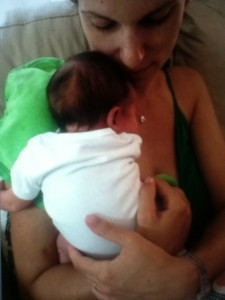I remember the shaking leading up to when I delivered. The sign, my nurse said, that things were happening, changing. That it was normal. But I’m shaking now, all these weeks later. Is this normal? . . .
My memoir began as running, single-spaced pages of notes like these. I’d open the Word document in the morning after my husband left for work and input what I’d often woken in the night to record on a pad of paper by the bed. Written in the dark, the scribblings weren’t always legible later, and I wondered if anyone else would be able to decipher what I transferred onto the computer — the outpourings of a woman who had lost her first child at six months pregnant, who had chosen not to let him live a shortened and severely negotiated life with just half a heart.
At the time, I had been working on a novel, but it now looked like someone else had written it. In truth, someone else had. I no longer wanted to read much less write fiction. Instead, I devoured memoirs that related to my experience. Elizabeth McCracken’s An Exact Replica of a Figment of My Imagination, Monica Wesolowska’s Holding Silvan: A Brief Life, and Lidia Yuknavitch’s The Chronology of Water all helped. They are stories not only about losing babies, but also of surviving them.
Three weeks after losing my son, Lorenzo, I couldn’t shake the need to release my own story from my body, where much of the trauma had occurred and where all of Lorenzo’s life had been lived. In Santiago, Chile, where we had moved from California two years earlier, our distance from those who knew us best added to the overall isolation. But I also found it a relief not to have to show anyone that I was okay when I wasn’t. Instead, I wrote, through my grief, which now felt like the most fundamental part of me, and with the wholly shifted perspective it had summoned. Energy, which is difficult to reclaim after loss, began brewing.
Part of that energy fueled a search — I was trying to understand the specifics of what had happened to our son, to my husband, and to me.
Lorenzo’s Hypoplastic Left Heart Syndrome wasn’t caused by anything I did or ate or drank. He had it because two or three or four out of 10,000 babies simply do. Overwhelmed and sometimes paralyzed by what we had had to do to spare him the pain of managing such a heart and the damage it would have caused the rest of his body once he was born, I felt compelled to retrace the steps that led to our impossible decision and to my hope that we had done right by our son. Finally, I needed to figure out how we were going to live with our choice, and without Lorenzo.
I knew it couldn’t wait, even though friends and publishing colleagues advised me to write once I had at least temporal distance. While time serves many personal stories, raw and undistracted immediacy seemed to serve mine. After feeling so alone during those early months, I also wanted eventually to help others by sharing our story. In vulnerability, there is strength.
After several weeks, I had over one hundred pages of every thought, emotion, and observation as it had come to me. What I didn’t have was structure. Finding it proved to be the most challenging part of the writing process. It helped to break down the experience into two stories.
The first was the intense week that began with the diagnosis of Lorenzo’s heart, which happened on a Monday in Santiago and ended with our decision to terminate, on a Friday in Northern California, where we had flown to gather second opinions and understand our options for treatment. Day by day, Part I asks the reader to walk alongside us as we learn about our son’s heart and the severe interventions that would be required to extend his life — but never guarantee it. In showing how we ultimately let our baby go, without his ever knowing pain, I aim to illuminate what is a rare, an isolating, and in many cases and countries a stigmatized experience.
The second part was everything that would follow that decision. But where to draw the line, especially as I was still living it? As I adopted a puppy to nurture, sought acupuncture treatment, began volunteering at an orphanage, and examined the medical, legal, and political framework for our decision? (The exact number of mothers like me, for instance, is undocumented and therefore unknown.) I decided to chart the first year: a monumental quantity of time to cross after losing a child, but a manageable period to document on the page.
By also limiting the story to a time period that wouldn’t necessarily see the arrival of another child, Lorenzo would remain at the forefront, which was vital to me. This is his story as much as mine.
At its most basic, shaping my notes into a memoir was an act of survival. Together, both parts of the story aim to decipher grief, and to help other parents like me or those who know parents who have gone through what we have. It’s important that we — that our babies — are seen.
When I reached the one-year anniversary of losing Lorenzo, I was newly pregnant. I didn’t know then what I know now, looking at my daughter as she naps next to my desk — that I would survive, and that she would, and that her heart would be whole. The odds were low that another child of ours would have a congenital heart defect like Lorenzo’s, but once you are the statistic it’s difficult to trust in anything like numbers.
The only number we wanted was four: four chambers of the heart. Until I saw them on the ultrasound screen and even after I did, all I had was hope.
♦ ♦ ♦
 A longtime magazine editor and contributor, Jennifer Massoni Pardini has been published most recently in The New York Times, San Francisco Chronicle, and Literary Mama. In 2011, she earned her MFA in English and Creative Writing from Mills College. Jennifer is currently completing work on her memoir Lorenzo’s Heart: The Anatomy of a Decision. She blogs at www.jennifermassoni.com and collects hearts in her son’s honour with The Chain-Link Heart Project.
A longtime magazine editor and contributor, Jennifer Massoni Pardini has been published most recently in The New York Times, San Francisco Chronicle, and Literary Mama. In 2011, she earned her MFA in English and Creative Writing from Mills College. Jennifer is currently completing work on her memoir Lorenzo’s Heart: The Anatomy of a Decision. She blogs at www.jennifermassoni.com and collects hearts in her son’s honour with The Chain-Link Heart Project.

Jennifer, thank you so much for writing this very moving piece. I am sure that your memoir will bring solace to so many — and I am very glad that writing it is providing that also to you! Best wishes.
Jennifer, love your writing and how you were able to share your vulnerability/strengh with us.
Jenifer,
This post was so moving and at the same time inspiring.
Wold love to read the entire memoir.
Really moving.
You’ve beautifully expressed how writing through an experience can lessen one’s pain, especially when the focus is on helping others face a similar challenge.